Katia took the initiative to start a Xenopus project in the lab a few years ago —and now her work is highlighted by Development! Huge congrats, Katia!
31.07.2025 10:39 — 👍 28 🔁 7 💬 0 📌 0
Feat. @guignardlab.bsky.social @pflenne.bsky.social @shamtlili.bsky.social @philipperoudot.bsky.social
The Tapenade pipeline is fully open-source with user-friendly notebooks and Napari plugins: github.com/GuignardLab/... 🫒
15.07.2025 11:48 — 👍 6 🔁 2 💬 1 📌 0

Sham Tlili, winner of the CNRS 2025 bronze medal - IBDM | Institut de Biologie du Développement de Marseille
A distinction that rewards a promising and already fruitful scientific career.
🥇Sham Tlili has been awarded the CNRS 2025 Bronze Medal! She studies how physical forces shape living tissues by using mouse stem cell models known as gastruloids. A unique blend of physics & biology.
🔗 Read more: www.ibdm.univ-amu.fr/sham-tlili-w...
27.06.2025 09:00 — 👍 44 🔁 14 💬 2 📌 0
Thank you so much for sharing your thoughts on our article!
10.04.2025 18:33 — 👍 10 🔁 0 💬 1 📌 0

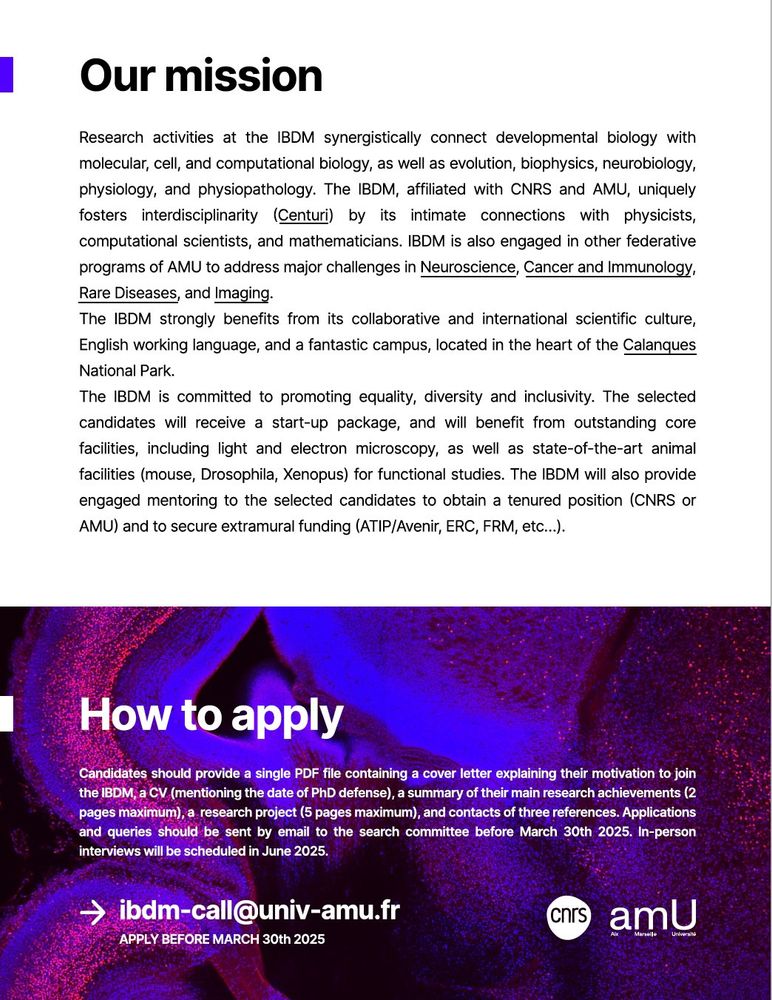
Excited to share that IBDM (Institut de Biologie du Développement de Marseille) is expanding its research groups this year! A great place for developmental biology and interdisciplinary research located on the beautiful Marseille-Luminy campus!
Deadline for applications: March 30th, 2025
17.01.2025 07:11 — 👍 57 🔁 51 💬 2 📌 1
Congrats on this beautiful work!
15.12.2024 14:21 — 👍 1 🔁 0 💬 1 📌 0
Thrilled that our team clinched both 1st and 2nd place in the image contest! 🥇🥈 Huge applause for everyone’s creativity and excitement in front of the microscope. Let’s keep inspiring each other! 💪✨ #Teamwork #Science
15.12.2024 14:17 — 👍 9 🔁 1 💬 0 📌 0
And usually, the sky is blue in Cassis, near Marseille!
19.11.2024 07:35 — 👍 5 🔁 0 💬 0 📌 0
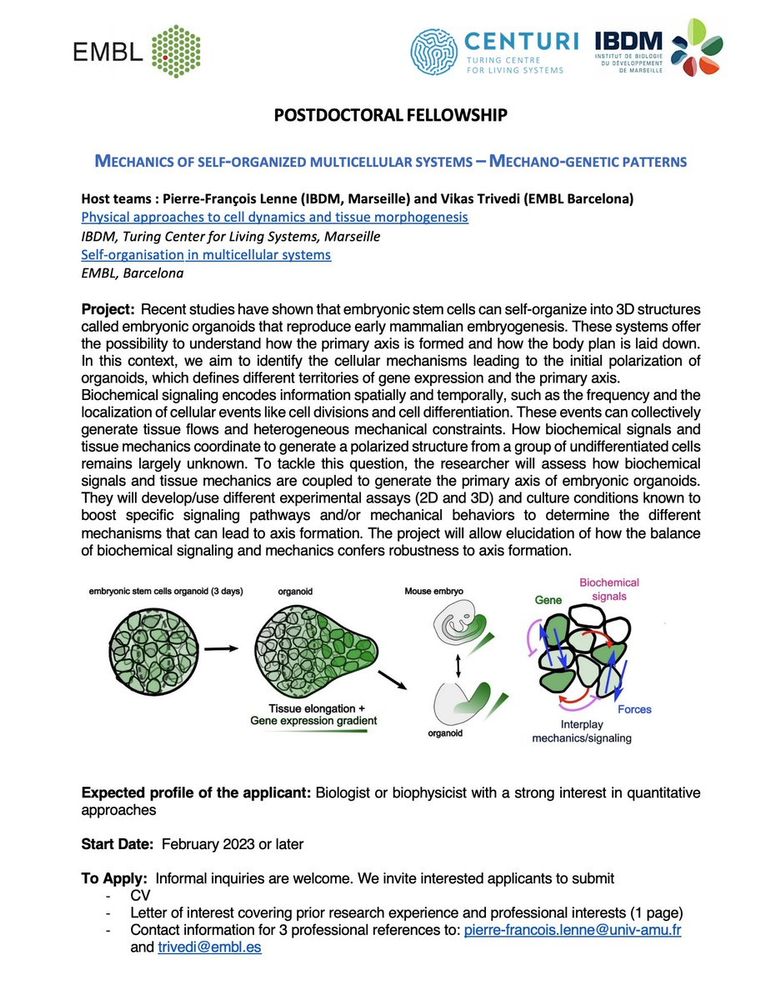
Vikas Trivedi's @LabTrivedi @EMBLBarcelona @the_prbb and my group @Equipe_lenne @IBDMmarseille @centuri_ls are recruiting for a Postdoc project on the emergence of mechano-genetic patterns using embryonic organoids!
Start Date: Feb 2023 or later
Informal inquiries are welcome!
20.10.2022 11:49 — 👍 0 🔁 0 💬 0 📌 0

The Munro (Chicago), Lenne and Rupprecht (Marseille) groups seek 2-3 postdoctoral fellows to join a newly funded (NSF/ANR) international collaboration on the multiscale dynamics of cell contact formation and remodeling.
10.05.2022 12:59 — 👍 15 🔁 21 💬 1 📌 0
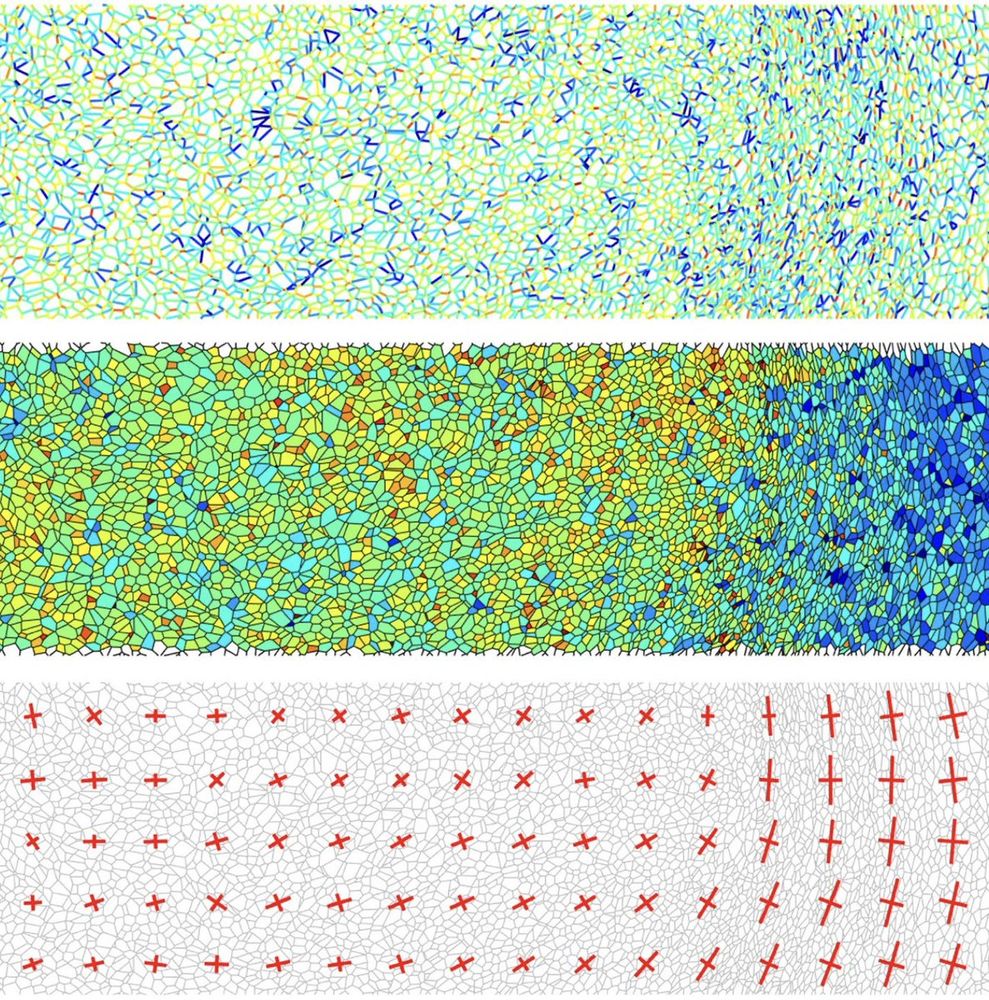
Our code for force inference in epithelial tissues is available online!
Feel free to contact us if you're interested in using it or if you want to collaborate.
Code :Ref :
nature.com/articles/s4159… data.mendeley.com/datasets/78ng4…
08.02.2022 10:33 — 👍 22 🔁 5 💬 1 📌 1
Very happy to welcome in our group Alice Gros @_AliceGros as a new Centuri @centuri_ls PhD student on a joint project with Léo Guignard @GuignardLab on morphogenesis of self-organized multicellular systems #Gastruloids
04.10.2021 13:29 — 👍 0 🔁 0 💬 0 📌 0
Roadmap for the multiscale coupling of biochemical and mechanical signals during development - IOPscience
Roadmap for the multiscale coupling of biochemical and mechanical signals during development, Pierre-François Lenne, Edwin Munro, Idse Heemskerk, Aryeh Warmflash, Laura Bocanegra-Moreno, Kasumi Kishi, Anna Kicheva, Yuchen Long, Antoine Fruleux, Arezki Boudaoud, Timothy E Saunders, Paolo Caldarelli, Arthur Michaut, Jerome Gros, Yonit Maroudas-Sacks, Kinneret Keren, Edouard Hannezo, Zev J Gartner, Benjamin Stormo, Amy Gladfelter, Alan Rodrigues, Amy Shyer, Nicolas Minc, Jean-Léon Maître, Stefano Di Talia, Bassma Khamaisi, David Sprinzak, Sham Tlili
Very grateful to great colleagues and pleased that our roadmap on multi-scale coupling of biochemical and mechanical signals during development is now onlinein IOPPBio @IOPPBio @WarmflashLab
@TimESaunders
@JgrosL
@a_michaut
@EdouardHannezo
@ZevGartner
ow.ly/eRun50EodEL
14.04.2021 16:16 — 👍 0 🔁 0 💬 0 📌 0
Very fortunate to welcome today a new postdoc in the group, Valentin Dunsing @DunsingValentin, who will explore/exploit "fluctuations" in morphogenesis.
01.04.2021 06:49 — 👍 1 🔁 0 💬 0 📌 0
Honoured and thrilled to become a EMBO member! A big thank you to all the great members of my team, past and present, and to my inspiring colleagues.
07.07.2020 15:33 — 👍 0 🔁 0 💬 0 📌 0
Cell-state transitions and collective cell movement generate an endoderm-like region in gastruloids
Shaping the animal body plan is a complex process that involves the spatial organization and patterning of different layers of cells. Recent advances in live imaging have started to unravel the cellular choreography underlying this process in mammals, however, the sequence of events transforming an unpatterned group of cells into structured territories is largely unknown. Here, using 3D aggregates of mouse embryonic stem cells, we study the formation of one of the three germ layers, the endoderm. We show that the endoderm can be generated from an epiblast-like state by a three-tier mechanism: a release of islands of E-cadherin expressing cells, their flow toward the tip of the 3D aggregate, and their segregation. In contrast to the prevailing view, this mechanism does not require epithelial to mesenchymal transitions and vice-versa but rather a fragmentation, which is mediated by Wnt/β- catenin, and a sorting process. Our data emphasize the role of signaling and cell flows in the establishment of the body plan. ### Competing Interest Statement The authors have declared no competing interest.
Our first paper on endoderm formation using #gastruloidswith @AMA_Lab
biorxiv.org/content/10.110…
24.05.2020 19:22 — 👍 0 🔁 0 💬 0 📌 0
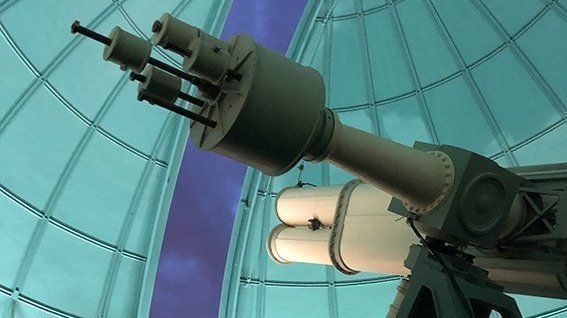
Signez la pétition
La recherche scientifique a besoin d’un plan d’urgence
Signez la pétition : La recherche scientifique a besoin d’un plan d’urgencevia @ChangeFrance
chng.it/DjnW7knV
13.05.2020 13:00 — 👍 0 🔁 0 💬 0 📌 0
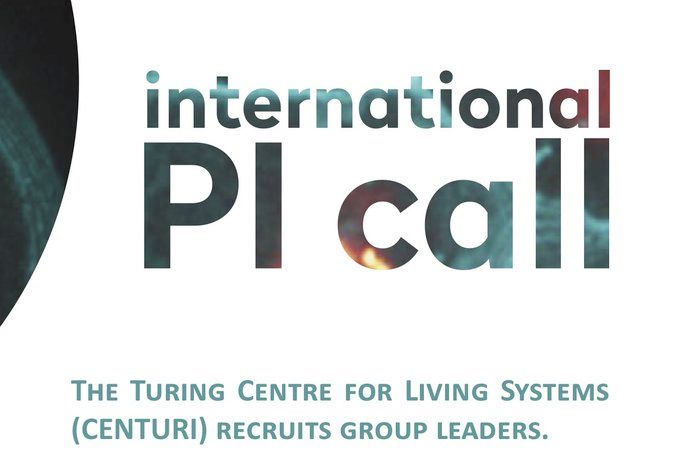
We seek to attract new PIs, computer scientists, physicists, or mathematicians with a theoretical and/or computational biology project, in the Turing Center for Living Systems (CenTuri) in Marseille.
View the offer here
⬇
centuri-livingsystems.org/wp-content/upl…
14.01.2020 10:09 — 👍 0 🔁 0 💬 0 📌 0
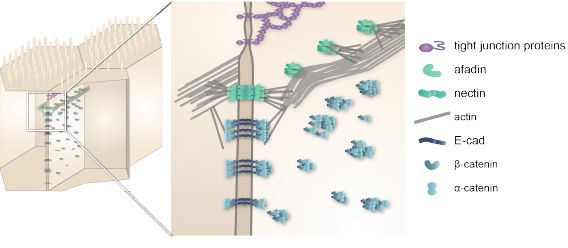
Check our latest manuscript on supramolecular architecture of epithelia:
biorxiv.org/content/10.110…
18.10.2019 08:14 — 👍 0 🔁 0 💬 0 📌 0

Last days to register/submit an abstract to our meeting on "Self-organization in multicellular systems" in Cargèse, Corsica, Sept 30 - Oct 4.
centuri-livingsystems.org/csm2019/
24.06.2019 15:06 — 👍 0 🔁 0 💬 0 📌 0
Girish's paper on how mechanical forces affect E-cadherin adhesion and junction dynamics is now onlineTowards a distinction between shear and tensile stresses.
rdcu.be/bb2Hp
27.11.2018 10:29 — 👍 0 🔁 0 💬 0 📌 0

This week, I participated in #Declics2018 with @CercleFSER. Half a day in a nearby high school to explain to students how knowledge progresses. A unique opportunity to share our experience as a researcher and answer students' questions.
25.11.2018 19:04 — 👍 0 🔁 0 💬 0 📌 0
Molecular logic of complex cell behaviors.
Orion Weiner's lab at UCSF. Account run by lab members.
#CellMigration #CellPolarity #Mechanics #OptoTools
weinerlab.com
Combining physical modeling, AI and computer vision to understand how cells self-organize into embryos and tissues. ERC DeepEmbryo. Team headed by @herveturlier.bsky.social
Prof. of Physics, Cell Biology and Molecular Engineering @ UChicago. Passionate about all the squishy matter driving dynamics and function from sub-cellular to tissue scales.
Biologist by profession, botanist by training, historian by heart. Researching 3D tissue morphogenesis from embryos to organoids
@TIFRscience @mpicbg @ETH @bsse
byakankshajain.blogspot.com
PhD student in the Petridou lab @EMBL 🐟🔬 Opinions are my own. | she/her
Biophysics of mitosis / mitotic spindle / chromosome segregation and aneuploidy
Head of Laboratory of Cell Biophysics at @institutrb.bsky.social, previously at @mpi-cbg.de, LENS Florence, Niels Bohr Institute, @hsph.harvard.edu, Uni Zagreb.
tolic.irb.hr
Explorer pour faire société - Transformer les défis contemporains en opportunités de progrès. Université citoyenne et responsable, nous explorons, nous inventons, nous partageons pour bâtir une société plus juste et durable.
https://www.univ-amu.fr
Biologist @hubrechtinstitute.bsky.social interested in signalling dynamics, development, tissue homeostasis and microfluidics | Formerly MPI Biochemistry, Biocenter Basel and Embl Heidelberg | Mother of 2 | Posts are my own.
Utrecht | sonnenlab.org
PhD student @EMBL Heidelberg in the Petridou Group
🔬🐟⚙️ ✨Morphogenesis, developmental biology, collectives
... all while loving outdoor action 🚵🏽♀️🍃🧗🏽♀️
Developmental biologist interested in embryonic self-organization.
Group leader at Institut Pasteur in Paris, France.
Cytokinesis, cell division, cytoskeleton, actin, ESCRT and viral budding.
https://research.pasteur.fr/en/team/membrane-traffic-and-cell-division/
CNRS Research Director
Single molecule fluorescence & smFRET of membrane proteins.
Director of the Center for Structural Biology. (@cbsmontpellier.bsky.social).
I collect photons nights & days (in the wild & in the lab)
Biophysics & Astrophotography here
Plant science from Enrico Coen's lab at the John Innes Centre.
https://rico-coen.jic.ac.uk/
PI @ibps.bsky.social. Mechanics of neuronal development - Olfactory placode morphogenesis - Cell movements - Axon growth - ECM - Zebrafish
https://www.ibps.sorbonne-universite.fr/en/research/development-adaptations-and-aging/mechanics-neuronal-development
PhD Student in Luca Giorgetti's Lab (@lucagiorgetti.bsky.social) - Genome architecture - Microscopy - Image analysis - Biophysics
Dev cell syst biol, cardiopharyngeal, coll migr, ecodevo. Dir Sars Centre, U Bergen. NIH DEV1 rev. Prof NYU Bio. Postdoc UC Berkeley. PhD CNRS/Paris XI. Agrégé. Archicube. French & American.
https://www.uib.no/en/michaelsarscentre/141681/christiaen-group
Cell and developmental biologist fascinated by forces, signaling and fate 🦟🐟 New PI @IMPvienna @viennabiocenter
Assistant Professor @biozentrum.unibas.ch • Theoretical biophysics • Postdoc ISTAustria, PhD LMU Munich, MSc Cambridge University
www.biozentrum.unibas.ch/brueckner











